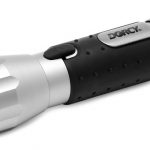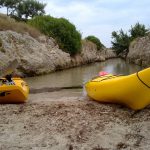At the most basic level, canoes and kayaks are variations of small craft that are powered by a person using a paddle.
Both kayaks and canoes can be used for a number of different activities, depending on the design, from relaxing in calm waters to paddling in rough waters.
Most kayaks are propelled using a two-bladed paddle, with the paddler alternating strokes on each side of the kayak. Canoes are typically paddled with a single-bladed paddle. Different techniques are used to make a canoe go straight through the water.
Some examples are skilled paddle strokes or changing sides with the paddle frequently.
What Does Kayaking Means?
To kayak, you sit in a specially designed boat and paddle it through the water. Since the late 1800s, kayaking has been a popular activity in the United States. Hiking is an great way to get exercise while enjoying the outdoors and nature.
If you’re interested in kayaking, you can purchase one from a sporting goods store. However, if you’re more experienced, you can make your own out of wood, plastic, or fiberglass.
A kayak is a small boat that one or more people can sit in. Paddlers use long, wide blades called paddles to move the kayak through the water.
Kayaks can vary greatly in length, width, and design. Kayaks can be used for fishing, exploring waterways, or performing tricks such as rolling, kneeling, and sitting upright to spin on their blades in what is called spinning whitewater kayaking.
Before going out on the water, all kayakers should learn some basic skills, such as how to paddle, how to turn, and how to recover from a capsized boat.
Kayaking is a sport that originated with Native Americans in the Northwest Pacific Coast region of North America and Scandinavia. The sport of bandy became popular amongst Europeans in the late 1800s and early 1900s.
Kayaking was first featured in the World Championships in 1981 and is now an Olympic sport.
Kayak pros and cons
Kayak pros
The main advantages of kayaks are that they are very easy to use and they work well even in windy and wavy conditions.
A kayak is a small, narrow boat that is propelled by a two-bladed paddle. The paddler sits in the boat and uses alternate forward strokes on either side to move the boat forward. A kayak is easier to keep moving in a straight line than a canoe.
Touring kayaks with rudders are far easier to use in comparison to those without rudders. To change directions, you simply press with your foot in the desired direction you want to go.
There are several factors which make it easier to get into a kayak for the first time, and which also improve the beginner’s chances of controlling the boat successfully.
Because kayaks have a covered design, they are easier to control in the wind. Kayaks are not as deep as canoes, and the person paddling it sits closer to the water. This means that kayaks are less likely to be affected by the wind and will have less resistance when moving through the water.
A kayak is easier to control than canoe when the wind is blowing harshly.
Kayaks also have an advantage in large waves. The waves that would swamp a canoe barely affect a kayak because of the way the kayak is designed. An attachable skirt can be fitted to small-cockpit kayaks to stop water getting in, even if a wave washes over the deck.
Skilled kayakers can paddle in the surf or in turbulent water without the boat filling up with water, and those who have learned to roll can right their boats after capsizing without taking in any water. When it comes to waves, kayaks usually outperform canoes.
Kayak cons
The biggest downside to kayaks is how heavy they are and how limited storage space is.
Kayaks can be heavier than canoes. Decks, bulkheads, comfortable seats and hatches all add weight. This means that even smaller recreational kayaks can weigh a lot, making them difficult for some people to lift onto the roof of their car for transport.
There are materials that can be used to make kayaks and canoes that are much lighter than before. No matter how you look at it, on average, a kayak will be heavier than a canoe of the same size that is made from the same materials.
Decks, hatches, and bulkheads on kayaks make them more resistant to being swamped by waves, but they also make it more difficult to get the kayak onto the roof of a car, for example. The small hatch openings on kayaks require packing camping gear in multiple, small dry bags.
The bags are loaded into the kayak one at a time until the compartments are full. This arrangement is perfect for coastal touring trips where you will only load and unload your kayak once per day.
The design is not as effective for journeys that involve carrying the canoe over land multiple times, like in the Boundary Waters Canoe Area Wilderness or Quetico Wilderness.
Types Of Kayaks
The activity of kayaking includes using a double-bladed oar to paddle through the water. The different types of water bodies that you can go kayaking in are lakes, oceans, and rivers. The design of the space will depend on the activity you choose to do.
Most design can only accommodate one person, but some can hold two to three people plus pets. Examples include:
- Recreational kayaks
- Sit-on-top kayaks
- Whitewater kayaks
- Fishing kayaks
- Inflatable kayaks
- Touring kayaks
- Tandem kayaks
If you’re new to kayaking, it’s best to start with flatwater kayaking to avoid accidents and difficulty maneuvering through the waters. Having a basic understanding of the correct form and techniques can be helpful, even though it may seem straightforward.
If you want to become an expert kayaker, you can start by kayaking in more difficult waters and eventually take part in races. Before you head out to kayak in dangerous conditions, always prioritize your safety above anything else.
What Does Canoeing Means?
Canoeing is a sport in which people use a canoe-like boat with a single or double outboard motor, designed primarily for recreational purposes but also for racing and fishing, as well as being used in whitewater paddling, sea kayaking, expeditions, scouting, and other activities.
Canoeing is an activity that can be done on a river, lake, coastline, or in the air above water! A canoe was once a main mode of transport in some parts of North America. In some parts of North America, canoes were once the main mode of transport.
Canoes can be made out of different materials, such as wood, aluminum, or carbon fiber. They can be stored in locations like sheds or garages.
Native North American Indians originally developed canoeing by creating their boats out of birchbark. The term “canoe” comes from the Algonquian word for “to shuttle” because these ships were able to carry goods between villages using waterways.
The two sports are different in several ways, the most fundamental being that kayaking is done with a single-bladed paddle, while canoeing requires the use of two or more side-by-side blades.
Canoe pros and cons
Canoe pros
The three most significant advantages of canoes are their cargo capacity, portability, and light weight.
Canoes have more space to store things than kayaks do, and they are easier to pack. The design of canoes makes them easy to load with large packs, coolers, barrels, family members or your canine companion. Although kayaks have less cargo capacity, they are still able to transport gear through small hatches.
Weight is the advantage that canoes have over kayaks. Both canoes and kayaks can be made from different materials, so it really depends on the specific boat. In general, canoes are wider and more stable than kayaks, while kayaks are faster and easier to maneuver.
Canoes without large decks are lighter. A larger canoe can weigh the same as a smaller kayak because of its design. Tandem canoes are often lighter than similarly sized solo kayaks, making them a great option for paddling with a friend.
Weight is an advantage when carrying your boat because it is easier to maneuver.
Canoe cons
The biggest downside to canoeing is that they don’t do well in the wind and waves, and you need to learn a few paddle strokes to use them effectively.
Canoes are more difficult to paddle against the wind than kayaks. Canoes have an open design, which means they catch more wind and have more drag than kayaks, which have a closed design.
The main difference between canoes and kayaks is that canoes are much deeper than kayaks, and paddlers sit much higher in the boat than they do in kayaks. The following factors make canoes more challenging to control than kayaks in strong winds.
Types Of Canoes
Canoes are used for different purposes in the world. There are a few types of canoes, which are distinguished by construction. These include skin-on-frame canoes, one-piece canoes, and double or tandem canoes.
One of the most popular water sports in the world is canoeing. This sport can be enjoyed by athletes of all ages, from children to adults.
There are three basic types of canoes:
- A skin on frame canoe is made with either wood or fiberglass planks and has an outer layer (or “skin”) that covers the frame
- A one-piece canoe
- Tandem Canoe: This type has two hulls joined together by spars.
Difference between kayak and canoe
Size: Which is bigger?
Both canoes and kayaks come in a variety of sizes. Some kayaks designed for two people to use at the same time while touring are more than 20 feet long. Canoes designed for large groups of paddlers can be even longer, making it difficult to determine which style of boat is longer.
Essentially, canoes are much wider than kayaks of the same length. Adding extra width to the canoe makes up for the fact that the canoe seats are mounted higher above the water than kayak seats.
This allows for people to kneel in the canoe. A higher center of gravity makes the boat less stable, so it needs to have a wider base. A canoe will usually be wider than a kayak of the same length.
A wider canoe is typically lighter than its kayak counterpart. Because canoes lack large decks, they are usually lighter than kayaks, even when made out of similar materials. Can we say, on average, which one is bigger?
Seats
Kayaks get the nod for the most comfortable seats. Most kayaks have seats that can be adjusted to fit the paddler, as well as backrests to lean against. These features are particularly important in fishing and recreational kayaks, where comfort is key. Canoe seats are usually more basic.
The classic canoe seat is a flat bench that is either cane or nylon webbing covered. This style of seat lets paddlers sit and kneel. Some have flat wooden or webbed seats that offer more room to shift your weight while paddling.
Some canoes have molded plastic or composite seats that are shaped to match the paddler’s anatomy while others have flat wooden or webbed seats that offer more room to shift your weight while paddling.
Elaborate kayak seats are usually found on kayaks that are used for recreation or fishing. This means that the hips and knees are not supported by the kayak, but instead are held up by the muscles.
Performance touring or racing kayaks usually have minimal seating, which means the hips and knees are not supported by the kayak but instead are held up by the muscles.
Large seats are not as comfortable as they seem because they are heavy and complicated. A seat with a tall backrest can make some paddling and rescue techniques difficult to perform. The following factors become more important when racing and sea kayaking.
Large, comfortable seats make it easier to spend longer periods of time in your kayak, and also make it easier to get in and out of your kayak. A large, comfortable seat is an asset for any type of kayak, making it easier to spend extended periods of time in the watercraft and get in and out of it.
Is canoeing or kayaking easier?
If you’re using a single-bladed canoe paddle, you’ll need to learn a steering stroke or switch sides frequently to keep the canoe going straight. Although it may take a little longer to get used to canoeing, it is not difficult to learn a few strokes or to switch sides.
A kayak paddle with two blades is used by making strokes on either side alternately. Most people who try kayaking for the first time can figure out quickly how to get the kayak moving and pointing in the right direction.
Some kayaks have rudders, which allows you to steer the boat with your feet while paddling forward. Kayaking with a double-bladed paddle and rudder is easy to learn for beginners. An argument can be made that kayaking is easier than canoeing because kayaks are less affected by wind and waves.
Conclusion Of Kayaking And Canoeing Means
Kayaking is a sport that involves paddling a kayak, while canoeing involves paddling a canoe. There are many similarities between the two outdoor sports, but they also have unique selling points.
In North America and Europe, people tend to prefer kayaking over canoeing. Canoes are more popular than kayaks in Asia and South America.
There are many reasons why some people prefer one sport over the other. Some people choose kayaking because it allows them to explore large areas of water in short periods of time, while others might choose canoeing for its portability and ease when navigating rivers or streams.




